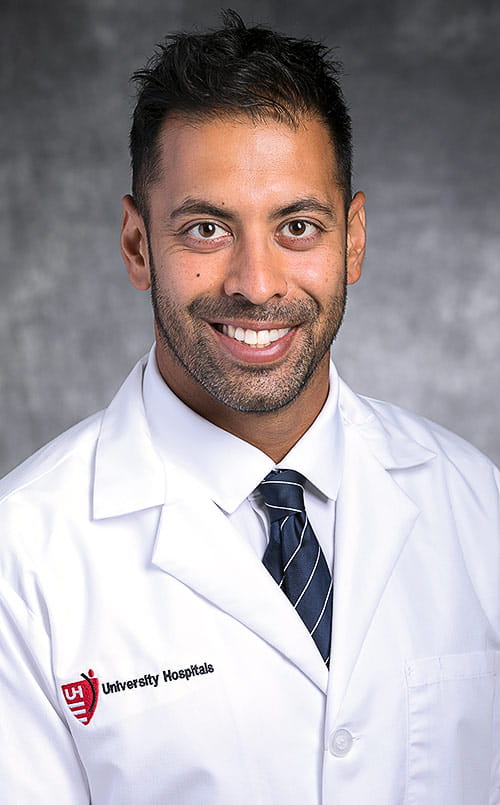New Director of Robotic Surgery for Total Joint Replacement Has an Expansive Vision of the Technology
June 24, 2025
UH Clinical Update | June 2025
University Hospitals has a strong history of success with manual total joint replacement. Those surgeries continue nearly every day at our hospitals, with outstanding patient outcomes. As in other medical fields, orthopedic technology is continually evolving. In the last few years, University Hospitals has expanded its ability to offer robotic joint replacement across many of its hospitals.
 Rikesh Patel, DO
Rikesh Patel, DORikesh Patel, DO, directs this effort at UH. Dr. Patel is a fellowship-trained orthopedic surgeon whose specialties include minimally invasive direct superior total hip replacement, muscle-sparing subvastus total knee replacement, partial knee replacement, complex primary joint replacement for post-traumatic and congenital deformities, and revision surgery for mechanical and infectious complications of total hip and knee replacement.
“Dr. Patel is a skilled expert in robotic total joint surgery. He is a great leader to represent our team of high-quality total joint surgeons at UH,” says James Voos, MD, Chair, Department of Orthopedic Surgery and the Jack and Mary Herrick Distinguished Chair, Orthopedics and Sports Medicine. “The UH robotic total joint program will continue to explore and develop advances in this field to keep us on the forefront of technology that can help patients have the best outcomes. Robotic surgery adds to our personalized, comprehensive options available for joint replacement at UH."
Perhaps not surprisingly, Dr. Patel is unabashedly enthusiastic about the advantages robotic total joint replacement provides for patients. The combination of advanced imaging with precision-guided instruments, he says, allows the orthopedic surgeon to personalize the surgical plan to each individual patient.
“It’s a more customized approach to joint replacement for each individual,” he says. “Ideally, that leads to better outcomes in the immediate post operative period and hopefully long-term.”
The robot is especially good, he says, for patients who have a pre-existing trauma or deformity that makes conventional instruments less than ideal. Dr. Patel says he can also use the surgical robot for patients who have orthopedic implants from previous surgeries to help three- dimensionally plan an operation. “We can work around them using robotics, without having to do additional operations to remove existing implants,” he says.
Although the technology is relatively new, early research results are promising, Dr. Patel says.
“What some studies are showing is that robotic surgery leads to less soft tissue damage, which ideally should lead to reduced pain,” he says. “This creates a bit of a butterfly effect -- less soft tissue damage, less pain and shorter hospital stays. This works hand in hand with our ever-growing outpatient joint replacement program.”
Dr. Patel surmises that implants from robotic total joint replacement may prove in the long run to be longer-lasting than others, reducing the need for repeat surgeries.
“More precisely controlled placement of implants and better functional outcomes should ideally lead better long-term function of the joint replacement,” he says.
As Director of Robotic Surgery for Total Joint Replacement for the system, Dr. Patel says his ultimate goal is to offer the procedure at every UH hospital. And while he sees its clear benefits, he’s quick to correct misconceptions about what the surgical robot can and can’t do.
“The robot is a tool,” he says. “It's not artificial intelligence. A tool is only as good as the person who uses it. We are continuing to recruit highly skilled surgeons who not only have strong manual skills for joint replacement but the ability to utilize technology in total joint replacement.”
That said, he notes he’s excited about the potential for growth.
“I’m focused on bringing cutting-edge technology into the operating room,” he says. “Our goal is to enhance surgical accuracy, reduce recovery times, and improve long-term outcomes for patients. It’s about leading a future-focused team committed to transforming joint replacement care. We're creating surgical efficiency that's reproducible.”


